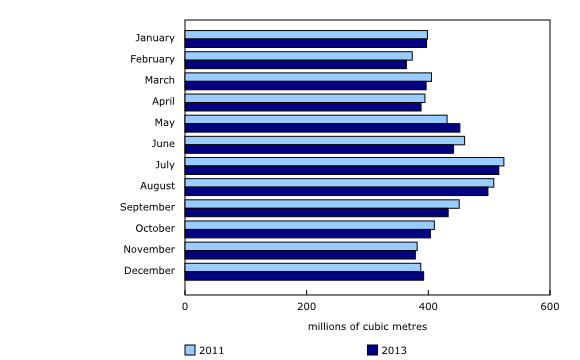Survey of Drinking Water Plants, 2013
Archived Content
Information identified as archived is provided for reference, research or recordkeeping purposes. It is not subject to the Government of Canada Web Standards and has not been altered or updated since it was archived. Please "contact us" to request a format other than those available.
Released: 2015-06-19
Drinking water plants produced 5 059 million cubic metres of potable water in 2013, down 1% from 2011.
The number of people that received their drinking water from plants that served communities of 300 or more people rose from just under 29 million in 2011 to 29.7 million people.
Total per capita water use, which accounts for residential, industrial, commercial and other uses of water provided by public utilities, averaged 466 litres per person per day in 2013, down 4% from 485 litres per person per day in 2011. The decline in per capita water use was influenced by both an increase in population and a decrease in drinking water demand.
The principal user of water, the residential sector, averaged 223 litres per person per day in 2013, down 11% from 251 litres per person per day in 2011.
Surface water sources, such as lakes and rivers, supplied 88% of the water, with groundwater and other sources making up the rest.
Nearly all the water treated by drinking water plants was filtered and disinfected in 2013. Just 1% of the population received untreated water, which came primarily from groundwater sources, unchanged from 2011. Chlorination remained the most common disinfection process, as it was applied to 95% of all drinking water produced in 2013.
Capital expenditures
Just over $1 billion in capital expenditures were made to upgrade existing infrastructure and commission new components of water treatment plants in 2013.
These upgrades included improvements to buildings, machinery, processing equipment and other physical assets related to the acquisition and treatment of water, but excluded infrastructure for water distribution. Capital expenditures in 2013 were down 23% from 2011.
Operation and maintenance costs
In 2013, $977 million was spent on operation and maintenance. These costs included expenditures on materials (chemicals and replacement parts), labour and energy, but excluded water distribution costs.
Labour costs were the largest component of these expenses, at $388 million, while materials accounted for $229 million and energy, $220 million. Other costs accounted for the remaining $140 million. Total operation and maintenance costs were nearly 11% higher than in 2011.
Note to readers
The target population is composed of drinking water treatment plants that are licensed and regulated by provincial/territorial agencies (excluding First Nations Communities) and that draw and process source/raw water from the environment to produce treated/potable water for consumption, serving 300 or more people.
Contact information
For more information, or to enquire about the concepts, methods or data quality of this release, contact us (toll-free 1-800-263-1136; 514-283-8300; infostats@statcan.gc.ca) or Media Relations (613-951-4636; statcan.mediahotline-ligneinfomedias.statcan@canada.ca).
- Date modified:


